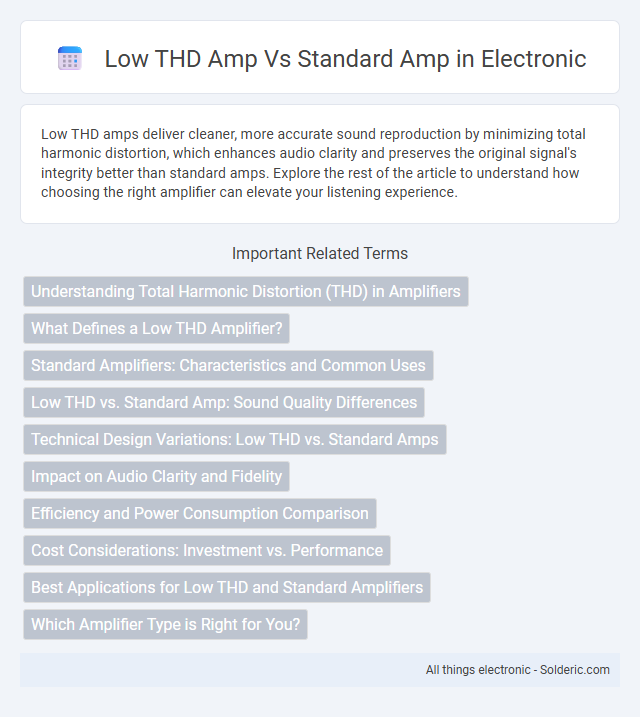Low THD amps deliver cleaner, more accurate sound reproduction by minimizing total harmonic distortion, which enhances audio clarity and preserves the original signal's integrity better than standard amps. Explore the rest of the article to understand how choosing the right amplifier can elevate your listening experience.
Comparison Table
| Feature | Low THD Amplifier | Standard Amplifier |
|---|---|---|
| Total Harmonic Distortion (THD) | < 0.01% | 0.1% - 1% |
| Sound Quality | Clear, accurate, minimal distortion | Standard fidelity with noticeable distortion |
| Cost | Higher, due to advanced components | More affordable, mass-produced |
| Use Case | Professional audio, high-fidelity systems | General consumer audio applications |
| Power Efficiency | More efficient with less signal degradation | Standard efficiency with possible heat loss |
| Signal-to-Noise Ratio (SNR) | High (usually > 90 dB) | Moderate (70-85 dB) |
Understanding Total Harmonic Distortion (THD) in Amplifiers
Total Harmonic Distortion (THD) measures the deviation of an amplifier's output signal from the original input due to harmonic frequencies generated during amplification. Low THD amplifiers produce cleaner, more accurate sound reproduction by minimizing unwanted harmonic distortion, enhancing audio fidelity for critical listening environments. Standard amplifiers with higher THD levels may introduce audible distortion artifacts, affecting sound clarity and overall performance quality.
What Defines a Low THD Amplifier?
A low THD amplifier is defined by its ability to minimize Total Harmonic Distortion, ensuring cleaner and more accurate audio reproduction. Unlike standard amplifiers, which may introduce more harmonic distortion due to less precise circuitry or components, low THD amps use advanced design techniques and high-quality components to maintain signal integrity. Your listening experience benefits from reduced distortion, resulting in clearer, more faithful sound across all frequencies.
Standard Amplifiers: Characteristics and Common Uses
Standard amplifiers typically exhibit higher Total Harmonic Distortion (THD) levels, which can introduce noticeable coloration to audio signals, making them less ideal for high-fidelity applications. These amplifiers are widely used in general consumer electronics, public address systems, and budget audio equipment where cost efficiency and power output are prioritized over audio purity. Your choice of a standard amp suits scenarios where sound quality demands are moderate, and affordability and robustness are critical factors.
Low THD vs. Standard Amp: Sound Quality Differences
Low THD amps deliver significantly cleaner and more accurate sound reproduction compared to standard amps, minimizing distortion and preserving audio fidelity. Your listening experience benefits from clearer highs, tighter bass, and a more natural overall sound, especially at higher volumes. Standard amps often introduce audible harmonic distortion that can color or muddy the audio, reducing clarity and detail in music playback.
Technical Design Variations: Low THD vs. Standard Amps
Low THD (Total Harmonic Distortion) amps feature precision-engineered components and optimized circuit topologies that minimize harmonic distortion, enhancing audio clarity and fidelity. Standard amps typically employ conventional designs prioritizing cost-efficiency over distortion control, resulting in higher THD levels and potential sound coloration. Your choice between these designs impacts the purity of audio reproduction, with low THD amps ensuring more accurate and cleaner signals for critical listening environments.
Impact on Audio Clarity and Fidelity
Low THD amps deliver superior audio clarity by minimizing distortion, preserving the original sound signal's purity and detail. Standard amps, with higher total harmonic distortion, often introduce audible artifacts that can mask subtle nuances in music, reducing overall fidelity. Choosing a low THD amplifier enhances your listening experience by maintaining accurate tonal balance and dynamic range.
Efficiency and Power Consumption Comparison
Low THD amplifiers deliver higher efficiency by reducing distortion-related power losses, resulting in lower overall power consumption compared to standard amplifiers. Your audio system benefits from improved energy usage, as low THD amps convert more input power into clean output signal with less heat dissipation. This optimization not only conserves electricity but also enhances amplifier longevity by minimizing thermal stress.
Cost Considerations: Investment vs. Performance
Low THD (Total Harmonic Distortion) amplifiers typically come with higher initial costs due to advanced components and precision engineering, reflecting their superior audio clarity and fidelity compared to standard amps. While standard amplifiers offer a more budget-friendly option, they often introduce more distortion, which can compromise sound quality in critical listening environments. Your investment in a low THD amp can yield long-term benefits through enhanced performance, making it a cost-effective choice for audiophiles prioritizing sound purity over upfront expense.
Best Applications for Low THD and Standard Amplifiers
Low THD (Total Harmonic Distortion) amplifiers are ideal for applications requiring high-fidelity audio reproduction, such as professional recording studios, audiophile sound systems, and medical imaging equipment, where signal purity is paramount. Standard amplifiers, with higher THD levels, suit less critical environments like public address systems, consumer-grade audio devices, and automotive sound setups, where slight distortion does not significantly impact performance. Choosing between low THD and standard amplifiers depends on the required sound accuracy and the sensitivity of the application to harmonic distortion.
Which Amplifier Type is Right for You?
Low THD amplifiers deliver cleaner, more accurate sound reproduction by minimizing total harmonic distortion, making them ideal for audiophiles and professional audio environments. Standard amplifiers offer a balance between performance and cost, suitable for casual listeners and general-purpose applications. Choosing the right amplifier depends on your audio fidelity requirements, budget, and listening environment.
Low THD amp vs Standard amp Infographic

 solderic.com
solderic.com